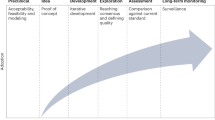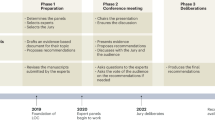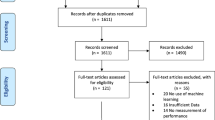Abstract
When building or renovating a laboratory animal facility, one must consider the requirements of the surgery program. The authors outline the critical considerations for designing a large-animal surgical suite.
This is a preview of subscription content, access via your institution
Access options
Subscribe to this journal
We are sorry, but there is no personal subscription option available for your country.
Buy this article
- Purchase on Springer Link
- Instant access to full article PDF
Prices may be subject to local taxes which are calculated during checkout








Similar content being viewed by others
References
Institute of Laboratory Animal Resources, National Research Council. Guide for the Care and Use of Laboratory Animals (National Academy Press, Washington, DC, 1996).
Association of Operating Room Nurses. Standards, Recommended Practices, and Guidelines (AORN, Denver, CO, 2002).
Office of Research Facilities, National Institutes of Health. NIH Design Policy and Guidelines (ORF, Bethesda, MD, 2003). http://des.od.nih.gov/eweb/policy/pdf/NIHDesignManual_1.04.pdf.
White, W.J. & Blum, J.R. in Anesthesia and Analgesia in Laboratory Animals (eds. Kohn, D.F., Wixson, S.K., White, W.J. & Benson, G.J.) 149–162 (Academic Press, New York, 1997).
American Institute of Architects. Guidelines for Design and Construction of Hospital and Health Care Facilities 23–25; 45–62 (AIA Press, Washington, DC, 2001).
Ruys, T. ed. Handbook of Facilities Planning, Vol. 2 (Van Nostrand-Reinhold, New York, 1991).
9 CFR, Chapter 1, Subchapter A–Animal Welfare, Parts 1, 2, and 3.
21 CFR, Food and Drugs, Part 58, Good Laboratory Practice for Nonclinical Laboratory Studies.
Ayliffe, G.A. Role of the environment of the operating suite in surgical wound infection. Rev. Infect. Dis. 13 (Suppl 10), S800–S804 (1991).
Mangram, A.J., Horan, T.C., Pearson, M.L., Silver, L.C. & Jarvis, W.R. Guideline for the Prevention of Surgical Site Infection, 1999. Centers for Disease Control and Prevention (CDC) Hospital Infection Control Practices Advisory Committee. Am. J. Infect. Control 27(2), 97–134 (1999).
US Department of Health, Education, and Welfare, Public Health Service, Center for Disease Control, National Institute for Occupational Safety and Health. Criteria for a Recommended Standard Occupational Exposure to Waste Anesthetic Gases and Vapors DHEW (NIOSH) Pub. No. 77-140 (US Government Printing Office, Washington, DC, 1977). http://www.cdc.gov/niosh/77-140.html.
Dharan, S. & Pittet D. Environmental controls in operating theatres. J. Hosp. Infect. 51(2), 79–84 (2002).
Sehulster, L., Chinn, R.Y. ; CDC; HICPAC. Guidelines for environmental infection control in health-care facilities. Recommendations of CDC and the Healthcare Infection Control Practices Advisory Committee (HICPAC). MMWR Recomm. Rep. 52(RR-10), 1–42 (2003).
Author information
Authors and Affiliations
Corresponding author
Rights and permissions
About this article
Cite this article
Talcott, M., Corey, M. Developing and Maintaining a Surgical Research Program: Surgical Suite Design. Lab Anim 33, 28–33 (2004). https://doi.org/10.1038/laban0604-28
Received:
Accepted:
Issue Date:
DOI: https://doi.org/10.1038/laban0604-28



